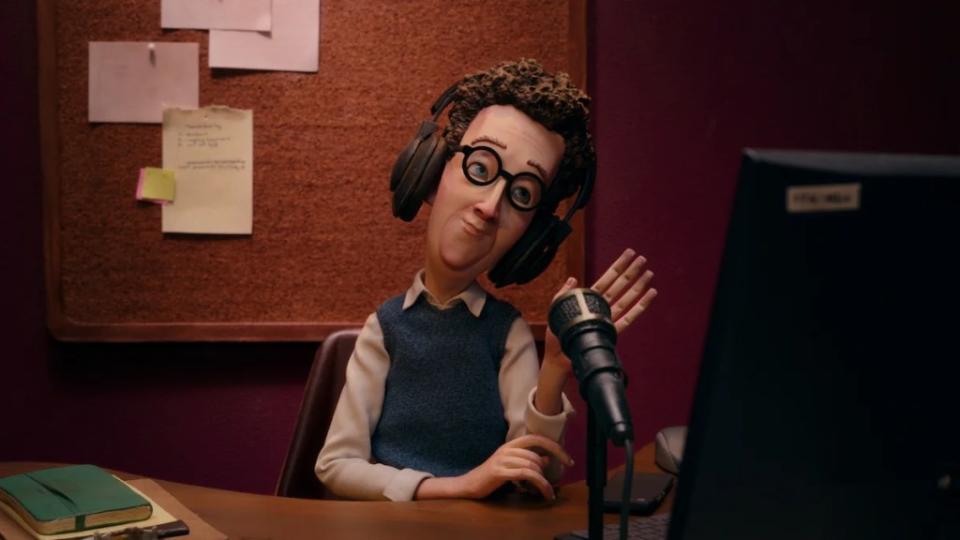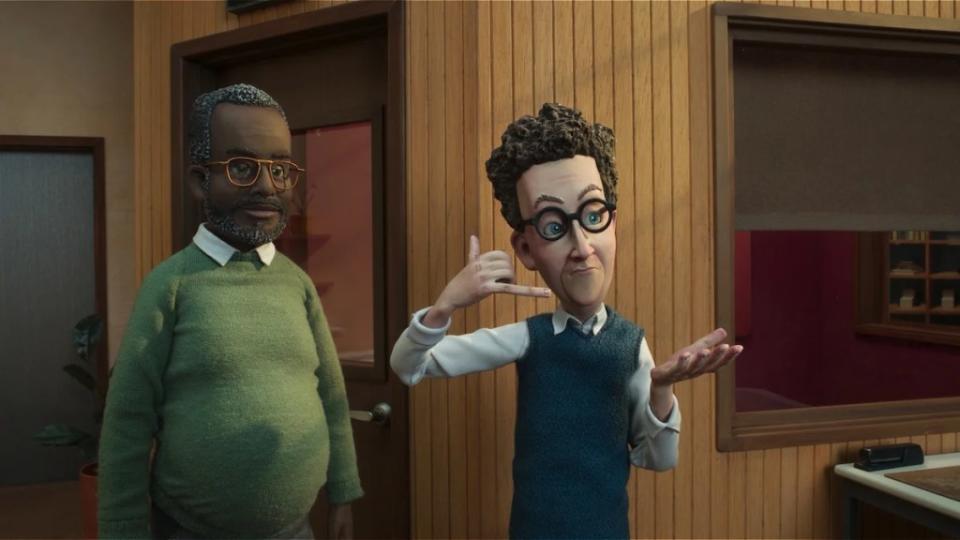The Strange Chemistry of ‘In the Know’: Stop Motion Animation Meets Woke NPR Weirdos
A stop-motion workplace comedy set in the very woke, furiously progressive world of an NPR talk show, Peacock’s “In the Know” is a collaboration between Mike Judge and the longtime team of Zach Woods and Brandon Gardner. Woods, best known for playing Gabe Lewis on “The Office” and Jared Dunn on “Silicon Valley,” voices Lauren Caspian, the “third most popular host on NPR” and an obsessively virtue-signaling interviewer for whom no social issue is too big to be viewed through the lens of his own fragile ego.
Each episode includes at least one interview with a live-action guest who appears on Caspian’s screen; those sequences are taken from hour-long interviews in which Woods and his guests (including Ken Burns, Finn Wolfhard, Mike Tyson, Hugh Laurie and Tegan and Sara) improvise their deliciously awkward conversations.
Was this an instantly appealing premise to you guys?
Zach Woods: For me, it was. I’ve often thought that if I wasn’t in my line of work, it would be great to be in your line of work, to interview people. To be able to take projects and people you find interesting and ask them all the nosy questions you want to ask would be a delightful way to spend a life. And so it was a little wish fulfillment, albeit through the personality of a fairly insufferable individual.
Brandon Gardner: I’ve always liked character comedy interviews. Like, I love Jiminy Glick and I love “The Colbert Report.” And as we expanded the idea to be more about the people that would work in an NPR studio, that was really appealing. It felt like it was an opportunity to make fun of our own shortcomings.
Zach and I are both progressives. We have these ideas and values and we don’t think those are funny, but we think the ways in which we fall short of them are funny.
Did you have to listen to an uncomfortable amount of NPR to be ready for this?
B.G.: That work was already done. [Laughs]
Z.W.: I was born listening to an uncomfortable amount of NPR.

What are the advantages of animation for a show like this?
B.G.: One advantage is that we wanted to tackle subjects that people sometimes get a little squirmy about. We hoped that animation would give us a little bit of leeway in the way that it has for a show like “South Park.” As beautiful as the characters look because of the craftsmanship, they are puppets, and hopefully that’s an invitation for people to not get instantly angry and to give the show a chance.
Z.W.: Also, because there are so many animators and voice actors, there’s so many human souls that go into any one stop-motion character. It’s funny and also sometimes touching that the characters include all of us. Meaning, like, every individual has the capacity to be any other individual because everyone’s got the same basic … I don’t know. I’m saying this in a vague and esoteric way. Basically, I just mean that people contain vast numbers of expressed and unexpressed characteristics. [Laughs] Man, someone edit me please, I beg you.
How about “We are large, we contain multitudes?”
Z.W.: Thank you! There we go.
Leave it to Walt Whitman. He has the words for it.
Z.W.: I don’t know. I prefer, “We have a variety of qualities that are expressed and unexpressed.” I think that’s somehow more poetic.
B.G.: Zach’s writing a book right now that’s Whitman’s poems rewritten by him.
The characters in the NPR office have such wonderful little biographical details. Like, Barb plays the recorder at the Unitarian Church. Where does that stuff come from?
Z.W.: I’m a sucker for Barb. My mom is 73 years old, and she was explaining how as you get older, as a woman in particular, you notice people sort of looking through you or around you. It’s not even malevolent, they just don’t register you in the same way. And you feel like you’re sort of fading into the wallpaper. People don’t solicit your opinion as much, people marginalize you in a way that you’re not even aware of sometimes. It made me so angry, but my mom was talking about it with a slightly wistful quality, but not any rage.
So we wanted to play with the idea that Barb has this incredibly vivid, rich inner life and past. Her husband was murdered and she’s dealing with that trauma. She was a war journalist in the Middle East. She has had a love affair with Hugh Laurie. She’s had this big, beautiful life and no one can see past the superficial details of her identity. And I think, for that reason, Barb is a personal favorite of mine.

As white liberals, did you have to make the Black character, Carl, less obviously flawed than some of the others?
Z.W.: [Laughing] That’s such a funny question. That’s a great question.
B.G.: Well, we were aware at some point, we don’t want Carl to be any less of a human than the others. And so that means showing him the respect of giving him flaws so that he’s not just this saintly person enduring everything. I think Carl is a safety freak. He’s like your dad who has a written-out plan about, like, the different things that could happen to the home and what everyone needs to do.
Z.W.: Yeah. He and Barb are both part of it. It’s generational, too. It’s less race and more age. [Laughs] We’re not racist, we’re ageist. But he and Barb have either outgrown the need to perform their personalities so loudly or just generationally never did it in the first place. What is absurd about Barb and Carl is much quieter. With both of them, it’s blink and you miss it—but if you don’t miss it, he’s weird. [Laughs] He’s weird.
This story first appeared in the TheWrap’s awards magazine. Read more from the Emmy magazines here.
The post The Strange Chemistry of ‘In the Know’: Stop Motion Animation Meets Woke NPR Weirdos appeared first on TheWrap.

